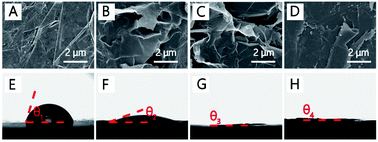In situ formed graphene nanosheets enhance bidirectional electron transfer in bioelectrochemical systems†
Abstract
Bioelectrochemical systems (BES) possess great potential for simultaneous wastewater treatment and energy recovery. However, the low bacteria loading and low electron transfer efficiency between biofilms and electrodes significantly limit the performance of BES and hence their practical applications. In this study, we constructed a graphene-modified electrode by utilizing an electrochemical exfoliating approach to form graphene nanosheets in situ atop a graphite electrode. These graphene nanosheets, which strongly anchored on the graphite base without the assistance of binders, significantly improved the biocompatibility and electron transfer of graphite. The proposed electrode delivered a 2.9-fold increase in the outward current (electron flux from bacteria to electrodes) and 10-fold increase in the inward current (electron flux from electrodes to bacteria) compared with the natural graphite electrode. This study presents a simple and cost-effective method to fabricate graphene-modified electrodes that hold great promise in BES applications.



 Please wait while we load your content...
Please wait while we load your content...